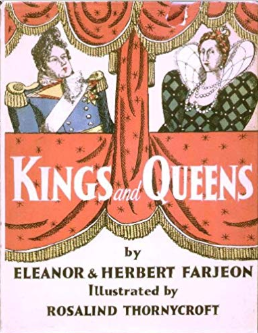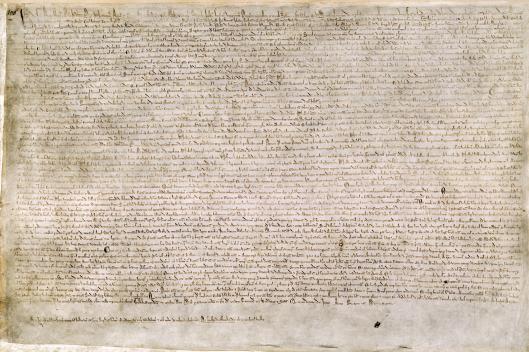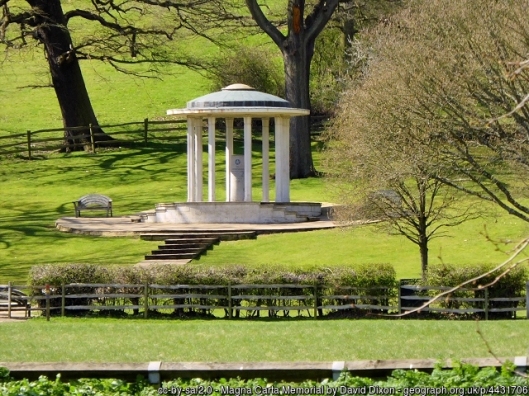 I learnt most of the little English history I know from a comical book in verse, first published in 1932, called ”Kings and Queens” by the playwright and critic Herbert Farjeon (1887 – 1945) and his sister Eleanor (1881 – 1965), a children’s writer. (Early editions have wonderful illustrations by Rosalind Thornycroft.) My father had ”Kings and Queens” when he was a child.
I learnt most of the little English history I know from a comical book in verse, first published in 1932, called ”Kings and Queens” by the playwright and critic Herbert Farjeon (1887 – 1945) and his sister Eleanor (1881 – 1965), a children’s writer. (Early editions have wonderful illustrations by Rosalind Thornycroft.) My father had ”Kings and Queens” when he was a child.
When Greg and I go to England in May we will visit Runnymede, where bad King John was made to sign the Magna Carta.
This is the ”Kings and Queens” account of it:
John, John, bad King John
Shamed the throne that he sat on.…
So the Barons brought a Deed
Down to rushy Runnymede,
Magna Carta was it hight,*
Charter of the People’s Right,
Framed and fashioned to correct
Kings who act with disrespect –
And with stern and solemn air,
Pointing to the parchment there,
‘Sign! Sign! Sign!’ they said,
‘Sign, King John, or resign instead!’
King John (r. 1199 – 1216) was my 24th great grandfather (many millions of people have him as an ancestor, of course).

The Magna Carta (originally known as the Charter of Liberties) of 1215, written in iron gall ink on parchment in medieval Latin, using standard abbreviations of the period, authenticated with the Great Seal of King John. The original wax seal was lost over the centuries. This document is held at the British Library and is identified as “British Library Cotton MS Augustus II.106”
The Magna Carta, which King John signed in 1215, means ‘Great Charter’. It established the principle in the English system of justice that everybody, including the king, was subject to the law. The Magna Carta had 63 clauses, most of them dealing with specific grievances associated with taxation. For example, the Charter demanded the removal of fish weirs from the Thames, the Medway and throughout England; the dismissal of several royal servants; and the standardisation of various weights and measures. However, there were clauses that established more fundamental values, and these have lasted for 800 years. For example the 39th clause gave all ‘free men’ the right to justice and a fair trial. The third clause is the most famous:
No free man shall be seized or imprisoned, or stripped of his rights or possessions, or outlawed or exiled, or deprived of his standing in any other way, nor will we proceed with force against him, or send others to do so, except by the lawful judgement of his equals or by the law of the land. To no one will we sell, to no one deny or delay right or justice.
A council of 25 barons, known as the Surety Barons, was appointed under clause 61 to monitor King John’s conduct. Somewhat surprisingly none of the barons were bishops or otherwise high in the hierarchy of the Church. The process of appointment is not known, but the names were apparently drawn almost exclusively from among John’s more active opponents.
Wikitree, an online collaborative worldwide family tree, has a project devoted to the Magna Carta. At this online tree I searched for my connection the Surety Barons using Wikitree’s relationship finder (this link and the links below are connected to my Wikitree profile. You can find out your connection to the barons by substituting your own Wikitree profile I.D.). Seventeen of the original 25 have known descendants past the fourth generation. I am related to all 17:
- William d’Aubigny: my 23rd great grandfather through my Chauncy forebears
- Hugh & Roger le Bigod: my 26th and 27th great grandfathers through my Dana > Kinnaird > Gordon forebears
- Henry de Bohun: my 26th great grandfather through my Dana > Kinnaird > Gordon forebears
- Gilbert & Richard de Clare: my 27th and 28th great grandfathers through my Dana > Kinnaird > Gordon forebears
- John Fitz Robert: my 25th great grandfather through my Dana > Kinnaird > Gordon forebears
- Robert FitzWalter: my 25th great grandfather through my Dana > Kinnaird > Gordon forebears
- William de Huntingfield: my 27th great grandfather through my Dana > Kinnaird > Gordon forebears
- John de Lacy: my 24th great grandfather through my Chauncy forebears
- William de Lanvallei: my 24th great grandfather through my Mainwaring > Pye > Crewe>Vaux forebears
- William Malet: my 25th great grandfather through my Dana > Kinnaird > Gordon forebears
- William de Mowbray: my 24th great grandfather through my Mainwaring > Pye > Crewe>Vaux forebears
- Saer de Quincy: my 26th great grandfather through my Dana > Kinnaird > Gordon forebears
- Robert de Ros: my 27th great grandfather through my Dana > Kinnaird > Gordon forebears
- Geoffrey de Say: my 24th great grandfather through my Dana > Kinnaird > Gordon forebears
- Robert de Vere : my 25th great grandfather through my Dana > Kinnaird > Gordon forebears
I am apparently descended from all of the barons who had descendants, but through three different lines: my Dana, Mainwaring and Chauncy lines. Many of the barons were related. I haven’t confirmed all the links myself yet. In using the pedigrees on Wikitree I depend on the work of other people, of course, and this is possibly not completely reliable.
The Wikitree project uses the work of Royal Ancestry: a Study of Colonial & Medieval Families by Douglas Richardson (2013), Volumes 1-5, and in Magna Carta Ancestry: a Study of Colonial & Medieval Families, also by Douglas Richardson (2011). These works focus on American colonists with Magna Carta ancestry and well-documented ancestral lines. Both my Dana and Chauncy lines are American colonial lines and are well documented, though in fact the Dana connections to the barons are not American colonial but Scottish.
I have potentially 67,108,864 24th great grandparents. The actual number will be a lot smaller because of pedigree collapse: the number of distinct ancestors reduces quickly when cousins, including distant cousins, have children together.
The number of descendants from those 24th, 25th, 26th, and 27th great grandparents is staggering. Some lines do die out, for example, 8 of the 25 surety barons are believed not to have descendants, but many millions of people are descended from those few people who signed a vow to enforce Magna Carta in 1215.
Sometimes I wonder why–or whether–genealogy matters. Establishing family connections is a sort of historical jigsaw puzzle, and I enjoy puzzles, but my interest in the Magna Carta really derives from its significance as a cornerstone of English – and so, Australian – law, not because of my remote connection to King John and the Surety Barons.

The Magna Carta Memorial includes a pillar of English granite on which is inscribed “To commemorate Magna Carta, symbol of Freedom Under Law”. The memorial was created by the American Bar Association (ABA) and was unveiled on 18 July 1957 at a ceremony attended by American and English lawyers. The memorial stands in the meadow known historically as Long Mede: it is likely that the actual site of the sealing of Magna Carta lay further east, towards Egham and Staines.
Footnote
* ‘Hight’ means ‘called’, or ‘named’.

King John was not a good man.
He had his little ways
And sometimes no one played
With him for days and days and days.
That, I am afraid, is about the extent of my knowledge of king John.
And on the ggggggggggg grandparent front, I give up!
LikeLiked by 1 person
There are too many ggggggggggg grandparents – they ahve many many descendants!
LikeLike
About ten years I went to visit a distant cousin who I’d met through my blog. Turned out he lived just over the hill from Runnymede. We had s beautiful day there. It’s gorgeous countryside
LikeLiked by 1 person
that’s so awesome you’re going to Runnymede. can’t wait to read about your trip! and i too learned my kings and queens from farjeon.
Joy at The Joyous Living
LikeLiked by 1 person
Pingback: The Salisbury Plain | Anne's Family History
Pingback: Up to London, not to visit the Queen | Anne's Family History
Pingback: Chauncy letter: pedigree back to Charlemagne via the Bigods | Anne's Family History